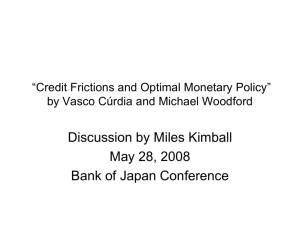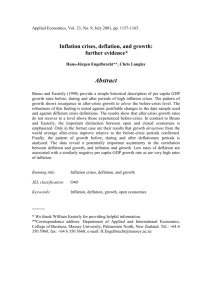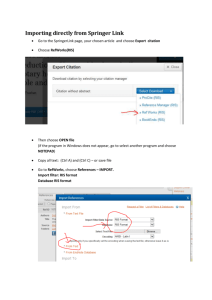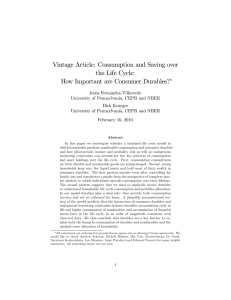The Recent Deflation in Consumer Durables Prices Box B
advertisement
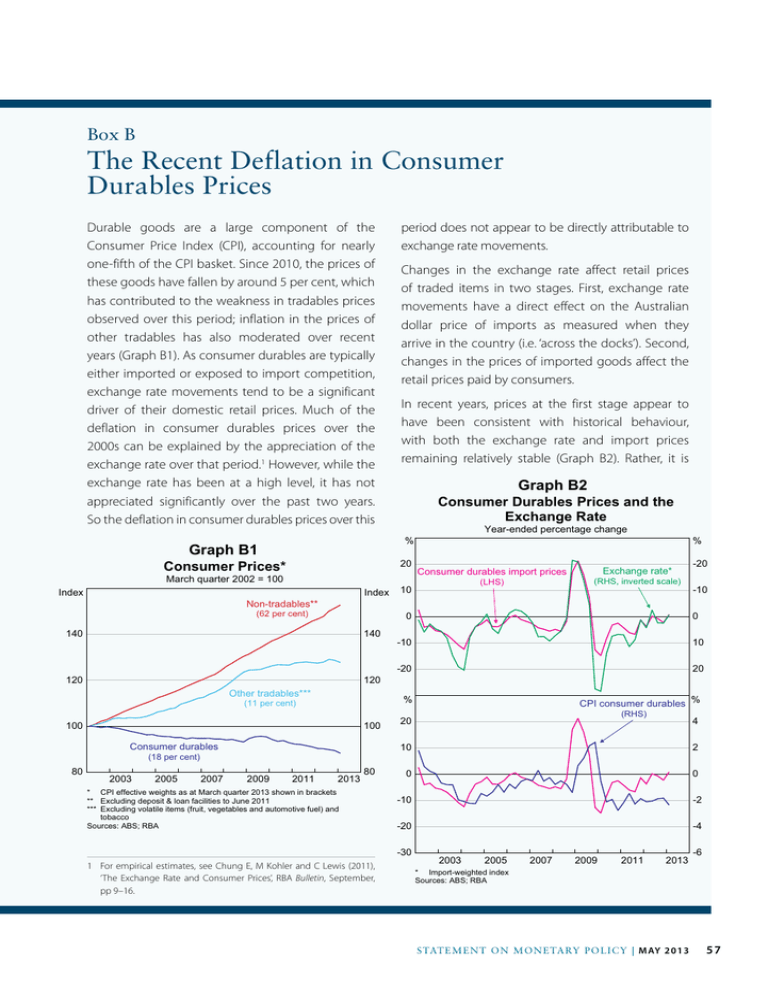
Box B The Recent Deflation in Consumer Durables Prices Durable goods are a large component of the Consumer Price Index (CPI), accounting for nearly one-fifth of the CPI basket. Since 2010, the prices of these goods have fallen by around 5 per cent, which has contributed to the weakness in tradables prices observed over this period; inflation in the prices of other tradables has also moderated over recent years (Graph B1). As consumer durables are typically either imported or exposed to import competition, exchange rate movements tend to be a significant driver of their domestic retail prices. Much of the deflation in consumer durables prices over the 2000s can be explained by the appreciation of the exchange rate over that period.1 However, while the exchange rate has been at a high level, it has not appreciated significantly over the past two years. So the deflation in consumer durables prices over this March quarter 2002 = 100 Index Non-tradables** (62 per cent) 140 120 120 Other tradables*** 100 100 Consumer durables (18 per cent) 2007 2009 Year-ended percentage change 2011 Consumer durables import prices (LHS) 10 % Exchange rate* (RHS, inverted scale) 2013 80 * CPI effective weights as at March quarter 2013 shown in brackets ** Excluding deposit & loan facilities to June 2011 *** Excluding volatile items (fruit, vegetables and automotive fuel) and tobacco Sources: ABS; RBA -10 -10 10 -20 20 CPI consumer durables % (RHS) 20 4 10 2 0 0 -10 -2 -20 -4 -30 1 For empirical estimates, see Chung E, M Kohler and C Lewis (2011), ‘The Exchange Rate and Consumer Prices’, RBA Bulletin, September, pp 9–16. -20 0 % (11 per cent) 2005 Graph B2 Consumer Durables Prices and the Exchange Rate 0 140 2003 In recent years, prices at the first stage appear to have been consistent with historical behaviour, with both the exchange rate and import prices remaining relatively stable (Graph B2). Rather, it is 20 Consumer Prices* 80 Changes in the exchange rate affect retail prices of traded items in two stages. First, exchange rate movements have a direct effect on the Australian dollar price of imports as measured when they arrive in the country (i.e. ‘across the docks’). Second, changes in the prices of imported goods affect the retail prices paid by consumers. % Graph B1 Index period does not appear to be directly attributable to exchange rate movements. 2003 2005 2007 2009 2011 2013 -6 * Import-weighted index Sources: ABS; RBA STATE ME N T O N MO N E TARY P O L ICY | m ay 2 0 1 3 57 the second stage of the relationship that appears to have deviated from historical norms, with retail price deflation continuing for an unusually long period beyond the stabilisation of import prices. A number of factors aside from import prices can affect the retail prices of traded goods, including domestic costs and margins that influence the prices facing consumers. However, even when account is taken of changes in domestic labour costs and productivity, the recent decline in consumer durables prices has been more pronounced than that implied by estimates based on historical relationships (Graph B3).2 This suggests that the recent decline in consumer durables prices has been due to other factors that contribute to retail prices, such as the non-labour costs of doing business and margins earned by retailers, wholesalers and domestic producers. This is consistent with the Graph B3 Consumer Durables Price Inflation Year-ended % % Actual values 2 2 1 1 0 0 -1 -1 Model-implied values* -2 -3 1993 1997 -2 2001 2005 2009 -3 2013 * The model is estimated from 1990:Q1 to 2007:Q4; model-implied values, using actual data for the independent variables (unit labour costs, import prices and inflation expectations), are shown from 2008:Q1 to 2013:Q1 Sources: ABS; RBA 2 One way of controlling for these influences is to use a mark-up modelling framework. In Graph B3, consumer durables prices are modelled as a mark-up over costs, which include unit labour costs (average labour costs per unit of output) as well as import prices (see Chung et al (2011)). As illustrated, there have been other episodes in the past where consumer durables price inflation deviated from such models. 58 R es erv e Ba nk of Aus t r a l i a Bank’s liaison, which suggests that these factors have had an important role in explaining the fall in consumer durables prices in recent years.3 Declines in the prices of household electrical items have made a particularly large contribution to the recent deflation in consumer durables (Graph B4). There has been rapid deflation of import prices for these goods for some time because of the earlier appreciation of the exchange rate and ongoing improvements in technology.4 However, the rate of deflation in the retail prices of household electrical items has been greater than that implied by the historical relationship between the retail prices and the import prices of these goods. Changes in import prices typically lead to substantially smaller changes in the prices paid by consumers because of the domestic costs in final prices. Even so, over the past two years, the average rate of deflation in the consumer prices of these items has been greater than the average rate of import price deflation. This has also been the case for a number of other consumer durables such as toys, books & leisure goods and motor vehicles & parts. Similarly, for some items, such as furniture and textiles, clothing & footwear, consumer prices have declined or remained flat while import prices have risen. There are a number of possible explanations for the apparent shift in the relationship between the import prices and the retail prices of these goods, most of which are not easy to gauge. In particular, liaison with businesses suggests that competitive pressures have been particularly pronounced in the past few years, which may in turn be partly attributable to the increasing presence of online vendors, based in Australia and overseas. One possibility is that retailers have responded by seeking to improve efficiency, for instance by streamlining distribution, 3 For details on the role of costs and margins, see D’Arcy P, D Norman and S Shan (2012), ‘Costs and Margins in the Retail Supply Chain’, RBA Bulletin, June, pp 13–22. 4 As the import and consumer price series are quality adjusted, quality improvements in household electrical items reduce the measured growth in their prices. negotiating lower rents, or cutting other overheads. These pressures may have also led to declines in the margins earned by retailers, as well as producers and distributors of goods and services further up the domestic supply chain. R Graph B4 Consumer Durables Price Inflation Average annualised inflation since March quarter 2011 Household electrical items Toys, books & leisure goods Consumer prices Import prices Motor vehicles & parts Furniture Textiles, clothing & footwear -12 Sources: ABS; RBA -9 -6 -3 % 0 3 6 STATE ME N T O N MO N E TARY P O L ICY | m ay 2 0 1 3 59

